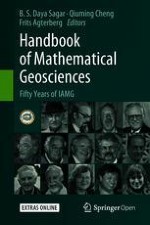The phenomena associated with continuous phase transitions are called critical phenomena, and these are often related to so-called self-organized criticality (SOC). SOC is commonly illustrated conceptually with avalanches resulting from piles of sand which generate a power-law number-size distribution of avalanche magnitudes (Bak et al.
1987). At the criticality point in a SOC phenomenon a small continuous input to the system can cause sudden and discontinuous outputs or avalanches. For example, a fault occurs in broken brittle rock strata when an extra stress is added to change the system at the criticality point. The size and number of faults generated may follow a power law distribution with a small number of large faults and a large number of small faults. SOC is similar to critical point phase transition since both processes involve anomalous state change caused by a minor continuous input pulse at the critical condition point. Numerous studies have also pointed out the effect of the 660-km endothermic phase transition on convection. This could actually generate the periodic occurrence of abrupt changes in convective mode (660-km layered/whole mantle), consecutive with the sudden flushing of oceanic plates previously accumulated above the transition zone (e.g., Le Bars and Davaille
2004). Many numerical simulations have demonstrated multiple scale and sizeable whole mantle convection, and sublithospheric convection can bring up dense fertile mantle materials from the lower mantle to the upper mantle (Korenaga
2004). Cold downwellings are temporarily stopped by the 660 km endothermic phase change but sink rapidly into the lower mantle (Tackley et al.
1993). The intermittence of layering reflects accumulation and release of negative buoyancy above the endothermic phase boundary (Machetel and Weber
1991; Tackley et al.
1993). The exchange of mass between upper and lower layers can occur in short bursts (Zhong and Gurnis
1994). Although these types of avalanching behaviors are not as easy to test as those of sand piles, one might reasonably assume that these types of processes with SOC nature can generate end products with power law distributions. As a matter of fact, SOC phenomena have been commonly considered to describe extreme geo-events in plate tectonics. Such examples may include but are not limited to earthquakes (Gutenberg and Richter
1944; Turcotte
1997), volcanic eruption durations (Cannavò and Nunnari
2016), plate sizes (Sornette and Pisarenko
2003), slab breakoff (Condie
1998), areal size of magmatism (Pelletier
1999), mineral deposits (Agterberg
1995; Cheng
1999b; Maier and Groves
2011), heat flow over mid-ocean ridges (Cheng
2016), episodic evolution of supercontinents and crustal growth (Cheng
2017b), and energy—probability of earthquakes (Cheng and Sun
2017). Other examples can be found in the book authored by Sornette (
2004). The processes involved in response to the preceding extreme events create end products which can be described by frequency—size or frequency—time power law relations. Based on the above reasoning, we may expect lithospheric root detachments and slab breakoffs that occurred during subduction are of difference sizes which follow power-law distributions. Some of these small-sized events may not be noticeable on the surface due to small impact on the global system, but the large detachments and slab breakoffs can cause significant impact on syn- to post-collisional magmatism and metamorphism. The size—frequency distribution of these types of events can be modelled by the following general power-law relation
$$ {\text{N}}( > {\text{A}}) = c{\text{A}}^{{ - {\text{b}}}} , $$
(10.19)
where A represents the size of event and N(>A) the cumulative number of events with size greater than the threshold A. This power-law function involves two constant values: c and b. For example, the well-known Gutenberg-Richter power-law distribution relates the number of large earthquakes to their sizes (Gutenberg and Richter
1944; Turcotte
1997). The exponent, b-value, has been commonly used for predictive purposes. The exponential b-value was found to be internally related to singularity in terms of fractal probability density (Cheng and Sun
2017) with
$$ E( < P) = E_{0} P^{{ - \frac{1}{\beta }}} , $$
(10.20)
where E(<P) represents the minimum energy released by large earthquakes, with occurrence probability less than P. This equation indicates that the minimum energy released by large earthquakes follows a power-law relation \( (\beta = \frac{2}{3}b) \) for probability of earthquake occurrence with energy greater than E. This model implies that the smaller the probability (P) of a large earthquake, the larger its energy release (E).
